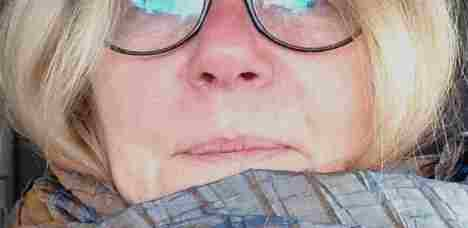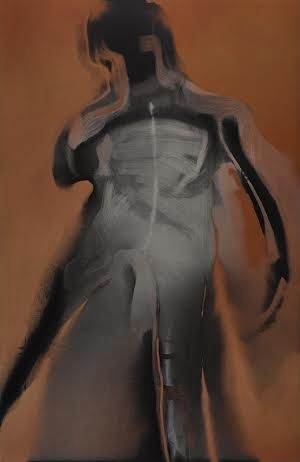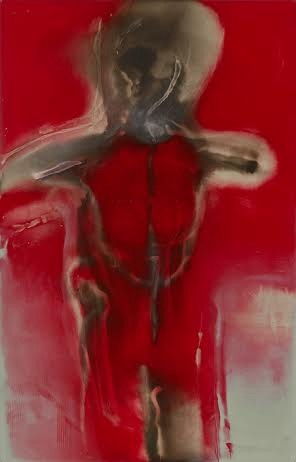metalwork and the art of
DARCIA LABROSSE

by
LYDIA
SCHRUFER
___________________________________________
IN
THEIR OWN WORDS
Sometimes
artists, featured in publications, aren't happy about the
way they've been portrayed, so I've decided that, from time
to time, I'll ask artists to write about themselves and their
work; Such is the case with Darcia Labrosse (www.labrosseart.com),
a dynamic innovative artist, whose work I admire. [L.S.]
A
PAINTER AHEAD OF TIME

BIO
I was born and raised in Montreal, Canada, of Swiss descent.
My father was a radio broadcaster and my mother was very artistic:
everything she touched turned to gold whether it was painting,
decorating, sewing or knitting. My parents’ apartment
housed the now defunct Montreal art gallery, VISUA. I grew
up surrounded by paintings by Riopelle, Borduas, Cosgrove,
the Group of Seven and Inuit soapstone. Art shaped who I was
to become.
I graduated from the Montreal Museum of Fine Arts School in
film animation and photography; my short films quickly won
critical acclaim. Further studies at Concordia University’s
Visual Arts Program, in lithography and painting, led me to
question the very meaning of painting and its inherent medium,
and the intimate subjective space we live in, but beyond appearance.
In
the last decade, I have developed the Metal Language
corpus, from which the paintings in this article are taken,
and which I label Existential Expressionism. I am branching
out from the Abstract Expressionist tradition, primarily because
of “its fierce attachment to psychic self-expression
. . . less a style than an attitude.”
I've
worked as an editor, translator, writer and illustrator. I
have published over40 books for children through HarperCollins,
Simon & Schuster, Hyperion and Random House in the US
and the UK. I have also been involved in the design of the
Artificial Intelligence semantic engineering Internet project
IEML (Information Economy Meta Language) at the Collective
Intelligence Lab at the University of Ottawa.
 I
now paint full time, dividing my time between different Ottawa
powdercoating factories and Montreal, where I am artist in
residence at the Fortmétal metalworks company. I also
spend a lot of time travelling from art fair to art fair,
from Miami-Basel to Armory or Volta in New York and visiting
galleries from Vancouver to Toronto, London to Brussels, still
looking for a gallery suited to my work. I am very much like
a salmon swimming upstream: most academia and galleries are
promoting conceptual art, installations with strong intellectual
tones. Art today is mostly about ideas whereas what I produce
is based on intuition and emotions.
I
now paint full time, dividing my time between different Ottawa
powdercoating factories and Montreal, where I am artist in
residence at the Fortmétal metalworks company. I also
spend a lot of time travelling from art fair to art fair,
from Miami-Basel to Armory or Volta in New York and visiting
galleries from Vancouver to Toronto, London to Brussels, still
looking for a gallery suited to my work. I am very much like
a salmon swimming upstream: most academia and galleries are
promoting conceptual art, installations with strong intellectual
tones. Art today is mostly about ideas whereas what I produce
is based on intuition and emotions.
In
2015, I will have solo shows in Toronto and in New Brunswick
and I will continue to participate in different group shows.
I
am profoundly a Montreal city girl; life and fate have taken
me elsewhere. I actually live in the Gatineau Hills surrounded
by nature, bears, lakes and beavers but I miss Montreal every
day.
INTRODUCTION
TO METAL LANGUAGE CORPUS
In this era of transhumance and deterritorialization, my work
is a trace left by a performance in a factory setting, far
from the habitual painting studio space.
 To
create the Metal Language corpus, as seen in part
on the website www.labrosseart.com, I have developed a unique
technique where Fine Arts and the industrial world merge.
I use a highly sophisticated medium generally used for colour
finishing and protecting architectural siding: electrostatic
paint, also known as powder-coating, on sheets of anodized
or untreated aluminium, copper or steel. This medium was chosen
for its endless possibilities and for its pigment vibrancy
and robustness.
To
create the Metal Language corpus, as seen in part
on the website www.labrosseart.com, I have developed a unique
technique where Fine Arts and the industrial world merge.
I use a highly sophisticated medium generally used for colour
finishing and protecting architectural siding: electrostatic
paint, also known as powder-coating, on sheets of anodized
or untreated aluminium, copper or steel. This medium was chosen
for its endless possibilities and for its pigment vibrancy
and robustness.
The process is intrinsic to my expression; a fast and conducive
method that facilitates immediacy of thought and feeling,
challenging a fine line between figuration and abstraction,
traveling from the unconscious to the conscious. Overcoming
the gravity of representation and the figurative, automatism
and acquired reflexes, I mix brute force and emotions to paint
ontological, disquieting, enigmatic  human
figures free from artifice, universal in its expression. My
paintings are simply embodiments of the human condition. Moving
through opalescence and a sometime monochromatic palette,
the work is evocative, seminal and suggestive of a pre-incarnation,
a transcendence evolving in an underlying objective space
where our senses are fired into a leap of perception.
human
figures free from artifice, universal in its expression. My
paintings are simply embodiments of the human condition. Moving
through opalescence and a sometime monochromatic palette,
the work is evocative, seminal and suggestive of a pre-incarnation,
a transcendence evolving in an underlying objective space
where our senses are fired into a leap of perception.
Rivets, bolts, studs, spikes, gold-plated screws and other
surgical stainless steel piercings are applied afterwards,
paradoxically exposing the immutability of the metal and acting
as a metaphor for life-like stitches, scars and marks to the
painted bodies.
Electromagnetic fields as a phenomenon, a life force and a
binding agent, have become a unique and essential partner
in my creative activity.
The end result is an art impervious to the elements: the paintings
can be displayed both on walls or safely exposed outdoors
where they easily morph into sculptures, adding a rich architectural
dimension to an otherwise intimate and delicate art.
WHY, WHAT DO I PAINT?
“Art is the distance that time gives to suffering.”
Albert Camus,Notebooks 1955
“I am a story-teller, and I have but a single story
-- man.” William Saroyan, 1933
My work is essentially intuitive, gestural action-painting
executed at the confluence of Fine Arts, alchemy and the rough,
cool detachment of the industrial world. It is constructed
in a state  where
contrasts meet and clash. On a technical level, my strong
interests in architecture, my welding apprenticeship followed
by years of aimless roaming through heavy industrial building
sites, ports, shipyards and foundries, led me to metal as
the appropriate medium for what I want to express.
where
contrasts meet and clash. On a technical level, my strong
interests in architecture, my welding apprenticeship followed
by years of aimless roaming through heavy industrial building
sites, ports, shipyards and foundries, led me to metal as
the appropriate medium for what I want to express.
Fascination
with the distorted human body is primary to my art ; echoing
the catastrophic events of Minamata with its indirect repercussions
on Butoh, the mummies of the Capuchin Catacombs of Palermo,
the five-thousand-year-old Iceman, and more recently, the
apocalyptic appearance of Rick Genest’s entirely tattooed
body as he represents himself as both art and skeleton. It
brings to mind Ensor, Soutine, Bacon’s fascination with
teratology, De Kooning, Dubuffet and the CoBrA movement, Basquiat,
Freud and so many other artists who have tried to push the
human body’s envelope without completely losing perspective
of its humanity.
In
my early twenties, I had the great privilege of meeting Kazuo
Ohno, one of the founder/dancers of the Butoh cultural movement.
He performed privately for me -- his body, literally, inches
away from mine -- engendered a profound epiphany. During his
exquisite performance of La Argentina, this one-on-one
connection provoked in me a deep emotional shock -- an awakening.
As a small child, I had watched a black and white documentary
on the discovery of World War II death camps. The forgotten
and intense sensations of malaise, angst, fright and confusion
left by the now famously iconic images of the self-destruction
of the human race instantly resurfaced to my conscious mind
with Ohno’s surreal presence, making Butoh a sort of
anchorage, an inspiration, a link to long lost images burrowed
and tucked away in my memory.  Butoh,
and its elements of Noh and Kabuki, itself inspired by film
noir, Antonin Artaud, Marquis de Sade, Jean Genet and Mishima’s
writings, and inspirited by German Expressionism and the Neue
Tanze movement became subtextual influences in my work, unseen
but subconsciously felt. Armed with draftsmanship and techniques
and practices as varied as lithography, printmaking, filmmaking
and photography, I visually communicate the repressed feelings
of a child questioning the madness of men and violent images.
In a nutshell, I'm looking for a way to overcome the distance
between the painter and a wounded body, and between a wounded
body and the universe.
Butoh,
and its elements of Noh and Kabuki, itself inspired by film
noir, Antonin Artaud, Marquis de Sade, Jean Genet and Mishima’s
writings, and inspirited by German Expressionism and the Neue
Tanze movement became subtextual influences in my work, unseen
but subconsciously felt. Armed with draftsmanship and techniques
and practices as varied as lithography, printmaking, filmmaking
and photography, I visually communicate the repressed feelings
of a child questioning the madness of men and violent images.
In a nutshell, I'm looking for a way to overcome the distance
between the painter and a wounded body, and between a wounded
body and the universe.
The
result is a visual dream within a dream, or more aptly, a
nightmare within a nightmare -- where an emotional body swims
back from the unconscious to the conscious mind, to finally
resurface and breathe. With as little interference as possible,
I try to save it from a virtual drowning -- for an instant.
I have narrowed down to the bare essentials, precisely what
is necessary to substantiate it. I am not interested in the
explicit: decor, perspective, narrative or facial definition.
Descriptive time has been erased to make an archetypal, feverish,
human form. By eliminating the figure/background dialectic,
I take a step back to an Abstract Expressionists’ time
where evocation gave the viewer space to win over the specific.
ABOUT
THE UNUSUAL MEDIUM I CHOOSE TO WORK WITH
DS: Can you conceive of getting to a stage where you had such
freedom in your handling of the brush that it became unnecessary
to interrupt the process with other practices?
FB:
But I use those other practices just to disrupt it. I’m
always trying to disrupt it. Half my painting activity is
disrupting what I can do with ease. I want a very ordered
image, but I want it to come by chance. From Interviews
with Francis Bacon” David Sylvester, Thames and
Hudson 1962-1979